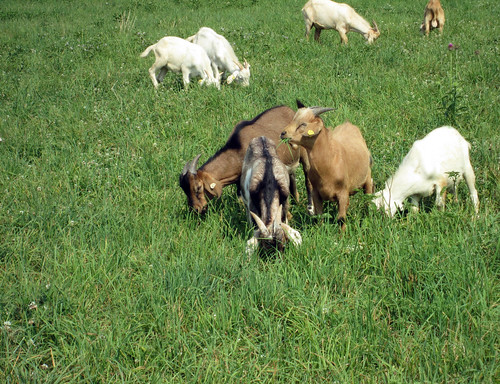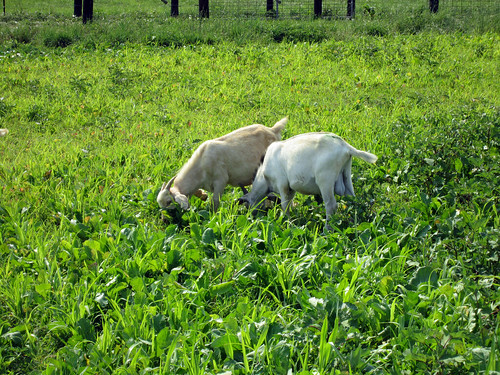Good weather and grazing conditions and relative "freedom" from worms allowed the goats to perform well during the first 14 days of the test. Only two of the 49 goats lost weight between June 14-15 and June 28.
For the first 14 days of the test, gain ranged from -3.0 to 11.5 lbs. and averaged 4.7 ± 2.4 lbs. (2.1 ± 1.1 kg). The median gain was 5 lbs. (2.3 kg).
On a per day basis, average daily gain (ADG) ranged from -0.214 to 0.821 lbs. per day and averaged 0.335 ± 0.174 lbs. (152 ± 79 g) per day. The median ADG was 0.357 lbs. (162 g) per day.
For the first weigh period, the top-gaining goat was a Kiko buck (#5) consigned by Kendall and Dana Barnes from Kentucky.
FAMACHA© scores ranged from 1 to 3 and averaged 1.9 ± 0.6, slightly better than two weeks ago. The median FAMACHA© score was 2. No goat required deworming. As expected, dosing the goats with worm larvae (on 6/21) had no effect on FAMACHA© scores. FAMACHA© scores are a measure of parasite resilience.
Body condition scores remained unchanged at 2.5 ± 0.3. Scores ranged from 1.5 to 3. The median body condition score was 2.5/5.0. Coat condition scores ranged from 1.5 to 2.5 and averaged 2.1 ± 0.2. The median coat condition score was 2.0/3.0. Few goats showed any evidence of scouring (diarrhea). Dag scores ranged from 0 to 2 and averaged close to zero. The median dag score was 0/5
A fecal sample was collected from the rectum from each goat. The individual samples are used to determine fecal egg counts (FECs). FECs are a measure of parasite resistance. A pooled sample was collected from random goats. The pooled sample is used to determine worm types. All fecal analyses are performed by Dr. Dahlia O'Brien's lab at Delaware State University.
The goats were worked today by Jeff Semler, David Gordon, Mary Beth Bennett, and Susan Schoenian. The goats were weighed by Jeff Semler. Data was recorded by Pam Thomas and a student volunteer. The goats will be worked next on July 12. Hot weather is expected.
Download July 28 d-14 report
For the first 14 days of the test, gain ranged from -3.0 to 11.5 lbs. and averaged 4.7 ± 2.4 lbs. (2.1 ± 1.1 kg). The median gain was 5 lbs. (2.3 kg).
On a per day basis, average daily gain (ADG) ranged from -0.214 to 0.821 lbs. per day and averaged 0.335 ± 0.174 lbs. (152 ± 79 g) per day. The median ADG was 0.357 lbs. (162 g) per day.
 |
| Bucks grazing cool season grass paddock. |
For the first weigh period, the top-gaining goat was a Kiko buck (#5) consigned by Kendall and Dana Barnes from Kentucky.
FAMACHA© scores ranged from 1 to 3 and averaged 1.9 ± 0.6, slightly better than two weeks ago. The median FAMACHA© score was 2. No goat required deworming. As expected, dosing the goats with worm larvae (on 6/21) had no effect on FAMACHA© scores. FAMACHA© scores are a measure of parasite resilience.
 |
| Bucks grazing "summer feast" (millet + rape). |
Body condition scores remained unchanged at 2.5 ± 0.3. Scores ranged from 1.5 to 3. The median body condition score was 2.5/5.0. Coat condition scores ranged from 1.5 to 2.5 and averaged 2.1 ± 0.2. The median coat condition score was 2.0/3.0. Few goats showed any evidence of scouring (diarrhea). Dag scores ranged from 0 to 2 and averaged close to zero. The median dag score was 0/5
A fecal sample was collected from the rectum from each goat. The individual samples are used to determine fecal egg counts (FECs). FECs are a measure of parasite resistance. A pooled sample was collected from random goats. The pooled sample is used to determine worm types. All fecal analyses are performed by Dr. Dahlia O'Brien's lab at Delaware State University.
 |
| Some of the bucks in the central lane way |
The goats were worked today by Jeff Semler, David Gordon, Mary Beth Bennett, and Susan Schoenian. The goats were weighed by Jeff Semler. Data was recorded by Pam Thomas and a student volunteer. The goats will be worked next on July 12. Hot weather is expected.
Download July 28 d-14 report











